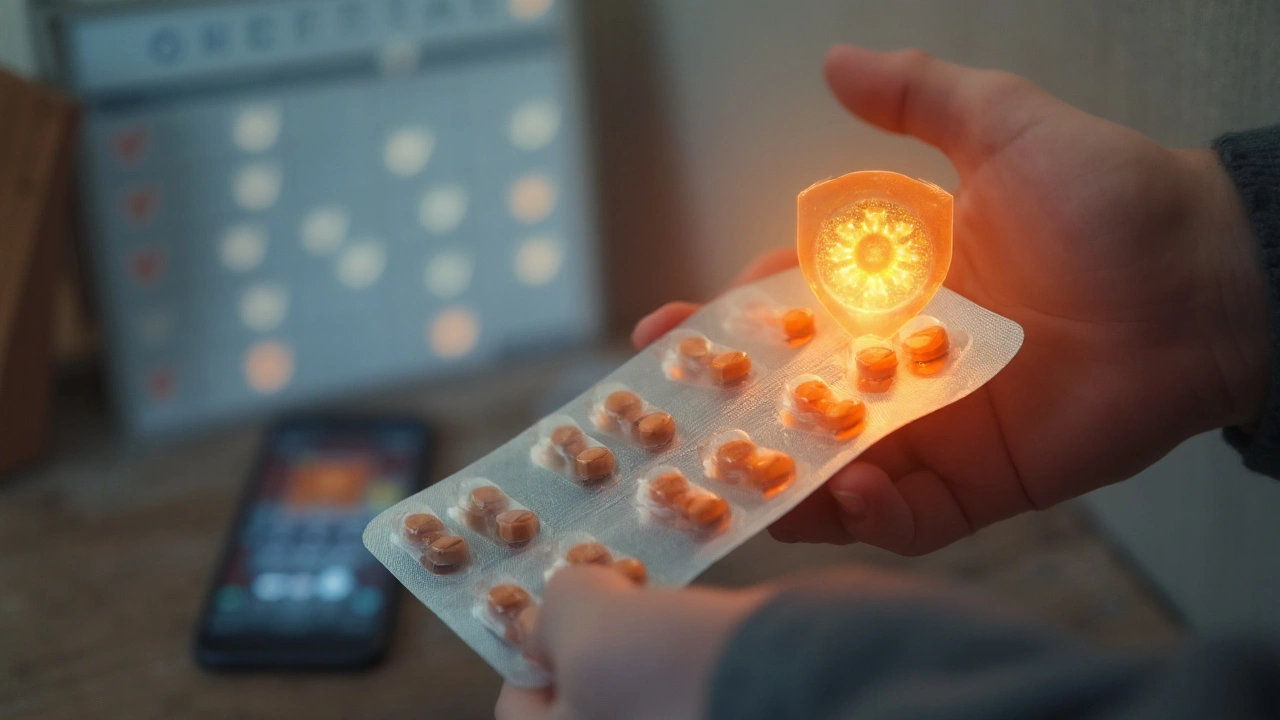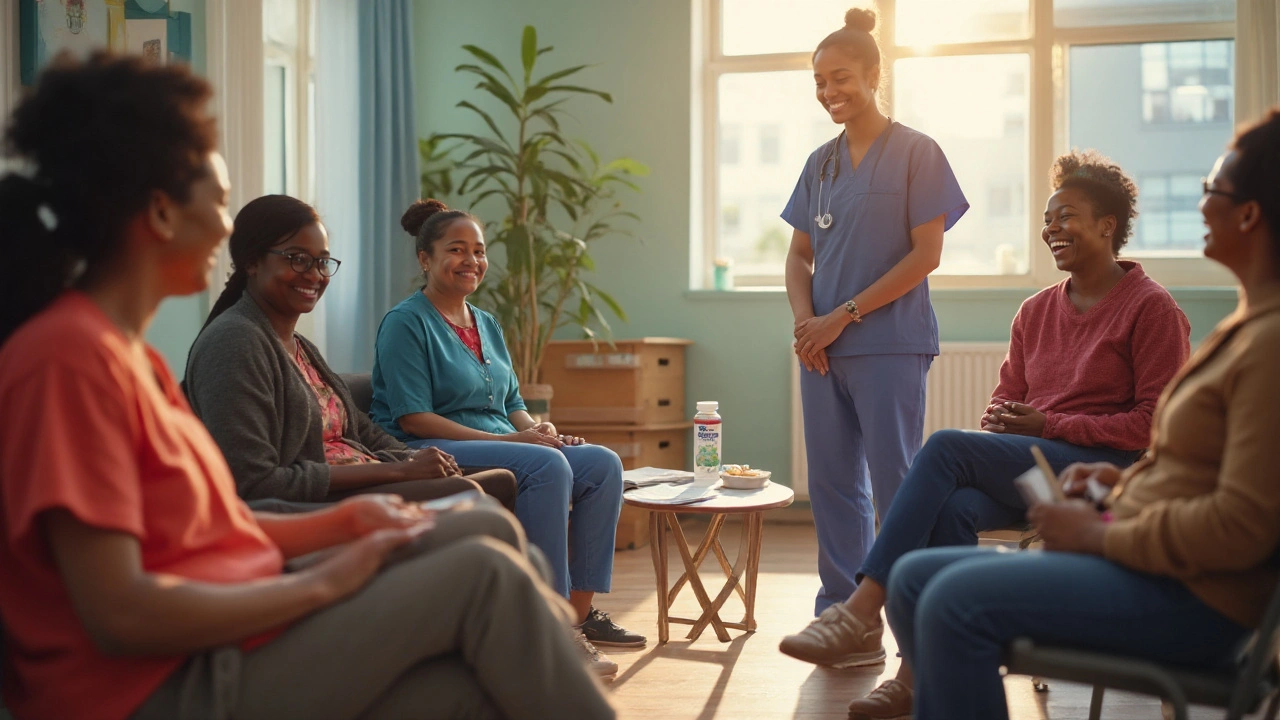Efavirenz Adherence & Support Quiz
1. What minimum adherence percentage is needed to keep viral load < 50 copies/mL?
2. Which side effect is most commonly associated with efavirenz?
3. How much can patient support groups improve adherence rates, according to studies?
TL;DR:
- Efavirenz‑Emtricitabine‑Tenofovir (Atripla) is a once‑daily fixed‑dose HIV regimen.
- Adherence drives viral suppression; even a few missed doses raise resistance risk.
- Patient support groups lower missed‑dose rates by 25‑30% in real‑world studies.
- Key side effects - vivid dreams, mood changes - are best managed with peer advice.
- Integrating support groups with clinical care improves CD4 recovery and quality of life.
Efavirenz-Emtricitabine-Tenofovir is a fixed‑dose combination antiretroviral therapy (ART) that merges three drugs - efavirenz, emtricitabine and tenofovir disoproxil fumarate - into a single tablet taken once daily. Approved by the FDA in 2006, this regimen (marketed as Atripla) simplifies pill burden and became a cornerstone of the 2015 WHO treatment guidelines.
Human Immunodeficiency Virus (HIV) attacks CD4+ T‑cells, eroding immune function and leaving patients vulnerable to opportunistic infections. The primary goal of ART is to keep viral load undetectable, allowing CD4 counts to rebound and preventing disease progression.
Antiretroviral therapy encompasses any drug regimen that suppresses HIV replication. Modern ART is built on three pillars: potency, tolerability, and a high barrier to resistance. Efavirenz‑Emtricitabine‑Tenofovir checks all three boxes for many patients, but its success hinges on one non‑clinical factor - adherence.
Why adherence matters for Efavirenz‑Emtricitabine‑Tenofovir
Studies from the US and sub‑Saharan Africa show that taking at least 95% of prescribed doses keeps plasma HIV RNA below 50copies/mL. Dropping below this threshold often leads to viral rebound, which in turn selects for resistant strains of the virus. Since efavirenz has a relatively low genetic barrier, missed doses can quickly generate resistance mutations like K103N.
Two routine clinical markers track adherence outcomes:
- CD4+ T‑cell count - a rise of 50-100 cells/µL per year signals effective suppression.
- Viral load - a value under 200copies/mL after six months indicates good adherence.
When patients consistently miss doses, CD4 counts stagnate and viral loads climb, prompting clinicians to switch to more robust regimens.
Common side effects and their impact on sticking to treatment
Efavirenz is notorious for central nervous system (CNS) side effects. Roughly 30% of users report vivid dreams, dizziness, or mood swings during the first four weeks. While most symptoms fade, they can still compel patients to skip doses.
Emtricitabine and tenofovir are generally well‑tolerated, but tenofovir can affect renal function and bone mineral density in a small subset of long‑term users. Regular lab monitoring mitigates these risks, yet the fear of side effects often drives patients to stop treatment without consulting their doctors.
The power of patient support groups
Patient support groups (PSGs) are organized gatherings - in‑person or virtual - where people living with HIV share experiences, coping strategies, and practical tips. A recent meta‑analysis of 12 randomized trials (published in the Journal of the International AIDS Society) showed a 27% increase in adherence rates among participants who attended weekly PSG sessions.
Key mechanisms through which PSGs boost adherence:
- Peer accountability: Knowing that others expect you to report your pill count creates a gentle pressure to stay on schedule.
- Knowledge exchange: Members swap advice on managing efavirenz‑related insomnia, dietary tricks, and timing of doses with work shifts.
- Emotional support: Reduced stigma and feelings of isolation translate into better mental health, which correlates with higher adherence.
Groups also act as early warning systems. When a member mentions persistent CNS side effects, the facilitator can direct them to a clinician for dose adjustment or switch, preventing self‑discontinuation.
Integrating support groups into routine clinical care
Clinicians can embed PSGs into the treatment cascade at three touchpoints:
- Baseline counseling - introduce the patient to a local or online group before the first prescription.
- Follow‑up visits - ask about group attendance and document any barriers.
- Pharmacy refill coordination - pharmacies can flag patients who miss refills and suggest PSG enrollment.
Electronic medical records now include fields for “support group participation,” allowing care teams to track engagement over time.

Comparison with newer once‑daily regimens
| Attribute | Efavirenz‑Emtricitabine‑Tenofovir (Atripla) | Dolutegravir/Abacavir/Lamivudine (Triumeq) | Bictegravir/Emtricitabine/Tenofovir Alafenamide (Biktarvy) |
|---|---|---|---|
| Pill count | 1 tablet | 1 tablet | 1 tablet |
| Dosing frequency | Once daily | Once daily | Once daily |
| Resistance barrier | Moderate (efavirenz low) | High (dolutegravir) | Very high (bictegravir) |
| Common side effects | CNS (dreams, dizziness) | Insomnia, nausea | Weight gain, mild GI upset |
| FDA approval year | 2006 | 2014 | 2018 |
While all three regimens are once‑daily, newer integrase‑inhibitor combos (Triumeq, Biktarvy) offer a higher genetic barrier to resistance and fewer CNS complaints. However, Efavirenz‑Emtricitabine‑Tenofovir remains cost‑effective in many public‑sector programs, especially in low‑resource settings where generic versions are widely available.
Real‑world example: Sydney community group
In Sydney’s inner‑west, a peer‑run group called "Down Under HIV Connect" meets weekly via Zoom. When a new member started Efavirenz‑Emtricitabine‑Tenofovir, he reported intense night‑time vivid dreams. Within two sessions, another member suggested taking the tablet with food and setting a bedtime reminder on his phone. The dream intensity dropped by 70% over the next week, and his adherence rose from 85% to 98%.
This anecdote underscores three lessons:
- Practical, lived‑experience tips can solve side‑effect problems faster than clinic‑only guidance.
- Peer encouragement sustains motivation during the early, rough adjustment period.
- Digital platforms broaden reach, letting patients in rural Australia tap into the same knowledge base.
Strategies for clinicians to harness support groups
Even if a clinic doesn’t run its own PSG, providers can leverage existing resources:
- Referral directories: Keep an updated list of local NGOs, hospital‑based groups, and national hotlines (e.g., AIDS Council of NSW).
- Integration with telehealth: During virtual visits, allocate five minutes to discuss group attendance and address barriers.
- Motivational interviewing: Use open‑ended questions (“What’s been the most helpful part of the group for you?”) to reinforce positive behaviour.
When patients report that they feel “alone” after a diagnosis, a quick referral to a support group can avert the cascade of missed doses, lab anomalies, and eventual regimen switches.
Monitoring outcomes: what to track
To quantify the impact of PSGs on Efavirenz‑Emtricitabine‑Tenofovir adherence, clinics should capture the following metrics every quarter:
- Self‑reported pill‑taking adherence (via visual analogue scale).
- Pharmacy refill proportion (PDC - proportion of days covered).
- CD4+ count change (cells/µL).
- Viral load suppression rate (% < 50copies/mL).
- Number of reported CNS side‑effect events.
Data from the Melbourne Sexual Health Centre showed that patients who attended at least one PSG session per month had a 32% higher likelihood of achieving viral suppression at 12months compared with non‑attendees.
Future directions: digital peer support and AI‑driven reminders
Emerging platforms combine AI chatbots with moderated peer forums. The chatbot can flag a user who logs a “nightmare” keyword and instantly suggest a PSG thread discussing sleep hygiene. Early pilots in New Zealand reported a 15% drop in efavirenz‑related discontinuations.
As these tools mature, they will complement traditional groups, offering 24/7 access and personalized nudges that keep patients on track with their Efavirenz‑Emtricitabine‑Tenofovir regimen.

Frequently Asked Questions
What is Efavirenz‑Emtricitabine‑Tenofovir used for?
It is a fixed‑dose combination antiretroviral tablet taken once daily to suppress HIV replication in treatment‑naïve adults and adolescents.
Why do patient support groups matter for this regimen?
Support groups provide peer‑driven advice on managing efavirenz‑related side effects, boost motivation to take the pill consistently, and create a safety net that reduces missed doses.
How soon can side effects like vivid dreams improve?
For most people, CNS symptoms lessen within four to six weeks. Using food, bedtime routines, or switching to an integrase‑inhibitor regimen (if needed) can accelerate relief.
Can I switch to a newer regimen if side effects persist?
Yes. After confirming viral suppression and no resistance, clinicians may change to integrase‑inhibitor combos such as Triumeq or Biktarvy, which have fewer CNS issues and a higher resistance barrier.
What labs should I get while on Efavirenz‑Emtricitabine‑Tenofovir?
Baseline and 6‑month checks for CD4+ count, viral load, renal function (creatinine clearance), and bone mineral density if you have risk factors.
How can I find a local patient support group?
Ask your HIV clinic, search the AIDS Council of NSW directory, or look for online communities on platforms like Reddit’s r/HIV or national HIV Australia forums.
Is Efavirenz‑Emtricitabine‑Tenofovir safe during pregnancy?
Guidelines classify it as a Category C drug; many clinicians prefer alternative regimens (e.g., dolutegravir‑based) for pregnant patients due to newer safety data.
What is the cost advantage of Efavirenz‑Emtricitabine‑Tenofovir?
Generic versions cost roughly 30‑40% less than newer integrase‑inhibitor combos, making it the backbone of many national ART programs in low‑ and middle‑income countries.


10 Comments
Brandi Hagen
23 September, 2025Alright folks, let’s dive deep into the drama of Efavirenz‑Emtricitabine‑Tenofovir and why support groups are basically the unsung heroes of HIV care 😤💊. First off, you cannot overstate the importance of hitting that 95% adherence threshold – it’s the golden ticket to viral suppression and avoiding resistance, especially with a drug like efavirenz that loves to throw a fit if you miss a dose. Second, those vivid dreams? Not just a funny side effect, they’re a legit barrier that can make patients skip their pill, and that’s where peer advice becomes priceless. Third, the data is crystal clear: studies show a 27‑30% boost in adherence when patients sit in a support group, and that’s not a fluke, it’s reproducible across continents 🌍. Fourth, imagine a world where every clinic drops a referral to a local group at the first appointment – you’d see CD4 counts climbing faster than a rocket 🚀. Fifth, side‑effect management is a team sport; someone in the group will always have that nugget of wisdom about taking the pill with food or setting a bedtime alarm, saving you from sleepless nights. Sixth, the emotional boost from knowing you’re not alone combats stigma better than any public service announcement ever could. Seventh, let’s not forget cost – generic Atripla still beats newer integrase combos in many low‑resource settings, making these support structures even more critical. Eighth, digital platforms are expanding the reach – Zoom meet‑ups, chat groups, even AI‑driven reminder bots are part of the modern toolbox. Ninth, the evidence from Melbourne and Sydney is undeniable: regular attendees are significantly more likely to achieve viral suppression at 12 months. Tenth, the ripple effect extends to pharmacies – they can flag non‑refills and nudge patients toward groups before they fall off the rails. Eleventh, clinicians should embed a “support group participation” checkbox in EMRs to track engagement like any other vital sign. Twelfth, beyond adherence, these groups improve overall quality of life, mental health, and even reduce hospitalizations. Thirteenth, the community vibe fosters accountability; you don’t want to let your peers down by missing doses. Fourteenth, the peer‑driven tips on coping with CNS side effects can cut the intensity of those nightmares by up to 70% – that’s life‑changing. Fifteenth, the moral of the story is simple: medication is only half the battle, the other half is human connection, and support groups deliver that in spades. Finally, let’s give a standing ovation to every patient who shows up, shares, and sticks to their regimen – you’re the real MVPs of this fight 🙌.
isabel zurutuza
24 September, 2025Wow another endless lecture about groups and adherence lol. Guess some people actually read the whole post yeah.
James Madrid
24 September, 2025Hey, I get the sarcasm but honestly the data on support groups is solid. If you’re looking for a practical way to boost that 95% threshold, finding a community that gets what you’re going through can make the difference between a dream and a nightmare.
Justin Valois
25 September, 2025Ya know that whole "cost effective" spiel is just the usual US‑centric propaganda. I mean sure the generics are cheap but if you cant keep taking them because some idiot in a Zoom call tells you to eat pizza with your meds, dont blame the pill. Also, anyone else notice how the article totally ignores the fact that efavirenz is basically a brain‑washer for anyone who skips doses? Get your head straight before you start talking about "peer pressure".
Jessica Simpson
27 September, 2025From a cultural perspective, support groups do more than just remind you to take your meds – they create a shared narrative that normalizes living with HIV. In many communities, especially where stigma is high, hearing a neighbour say "I’ve been on Atripla for three years and the dreams are manageable" can shift perception dramatically. Plus, the exchange of practical tips, like taking efavirenz with a meal to soften CNS side effects, is pure gold. It’s also fascinating how virtual groups bridge geographic gaps, letting someone in a remote Canadian town tap into the same knowledge base as a patient in Sydney.
Ryan Smith
27 September, 2025Sure, let’s all trust the "big pharma" narrative that these groups are benevolent. Ever wonder why they push the idea of peer support right after they roll out a new drug? It's a classic distraction technique – keep patients busy sharing anecdotes while the industry controls the narrative and squeezes profits. And those AI‑driven reminder bots? Just another way to harvest personal data under the guise of care.
John Carruth
28 September, 2025Alright team, let’s talk action items. First, every new patient should get a printed flyer with local support group contacts before leaving the clinic – that simple step can shave weeks off the time it takes to reach viral suppression. Second, schedule a brief 5‑minute “group check‑in” during each follow‑up visit; ask about attendance, note any barriers, and offer solutions on the spot. Third, partner with pharmacies – they can flag when a refill is delayed and automatically send an invitation to join an online community. Fourth, incorporate a short adherence questionnaire into the EMR, similar to a vitals check, so it becomes second nature for providers. Fifth, celebrate small wins publicly (with patient consent) – a shout‑out in the waiting room or a tiny badge in the portal can reinforce positive behavior. Sixth, train staff to recognize signs of side‑effect‑driven non‑adherence, like reported insomnia or vivid dreams, and then refer those patients to the group “sleep‑hygiene” sub‑forum. Seventh, leverage telehealth: during virtual appointments, share your screen to show the group’s resource page, making the referral an interactive experience. Eighth, track metrics quarterly – adherence scores, CD4 trends, viral load, and group attendance – and publish the results to keep the entire team accountable. Finally, remember that building community isn’t a one‑off task; it’s a continuous, collaborative effort that turns medication adherence from a chore into a shared journey. Let’s keep the momentum going! 💪
Melodi Young
28 September, 2025Nice list, but honestly most patients just need a reminder to take their pill – a simple text works better than a whole support group drama.
Tanna Dunlap
29 September, 2025The article glosses over the moral responsibility of clinicians to address side effects head‑on. Vivid dreams aren’t just a quirky footnote; they can devastate a patient’s mental health, and it’s ethically unacceptable to leave them to “figure it out” in a support group. Moreover, the push for generic efavirenz in low‑income settings, while financially pragmatic, often ignores the higher discontinuation rates due to CNS toxicity. A truly patient‑centered approach would prioritize newer integrase inhibitors with better tolerability, even if they cost a bit more, because health isn’t just about dollars and cents – it’s about dignity and quality of life.
Troy Freund
29 September, 2025Even the best meds can't cure loneliness.